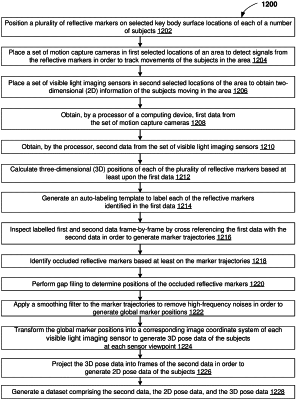| CPC G06T 7/70 (2017.01) [G06T 5/70 (2024.01); G06T 7/20 (2013.01); G06V 20/70 (2022.01); G06T 2207/30204 (2013.01); G06T 2207/30241 (2013.01); G06V 2201/07 (2022.01)] | 20 Claims |

|
11. A computer-implemented method, comprising:
positioning a plurality of reflective markers on selected key body surface locations of each of a number of subjects;
placing a set of motion capture cameras in first selected locations of an area to detect signals from the plurality of reflective markers in order to track movements of each subject in the area;
placing a set of visible light imaging sensors in second selected locations of the area to obtain two-dimensional (2D) information of the number of subjects moving in the area;
obtaining, by a processor of a computing device, first data from the set of motion capture cameras;
obtaining, by the processor, second data from the set of visible light imaging sensors;
calculating three-dimensional (3D) positions of each of the plurality of reflective markers based at least upon the first data;
generating an auto-labeling template to label each of the plurality of reflective markers identified in the first data;
inspecting labelled first and second data frame-by-frame by cross referencing the first data with the second data in order to generate marker trajectories;
identifying occluded reflective markers based at least on the marker trajectories;
performing gap filing to determine positions of the occluded reflective markers;
applying a smoothing filter to the marker trajectories to remove high-frequency noises in order to generate global marker positions;
transforming the global marker positions into a corresponding image coordinate system of each visible light imaging sensor to generate 3D pose data of the number of subjects at each sensor viewpoint;
projecting the 3D pose data into frames of the second data in order to generate 2D pose data of the number of subjects; and
generating a dataset comprising the second data, the 2D pose data, and the 3D pose data.
|